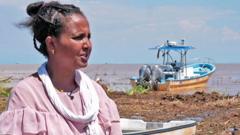As the sun dipped below Lake Turkana, a grieving mother wept, scattering flowers into the lake's deep waters in memory of her daughter who perished while attempting to migrate to Kenya using perilous routes orchestrated by human smugglers. Senait Mebrehtu, a 35-year-old Pentecostal Christian from Eritrea, visited the site in north-western Kenya where her 14-year-old daughter, Hiyab, lost her life after the ill-fated crossing last year.
Hiyab had been traveling with her sister, who miraculously survived the night's treacherous journey across the lake, notorious for its unpredictable winds and dangerous conditions. "Had I known about the vast and perilous lake they would face, I would never have permitted my daughters to attempt this journey," Ms. Senait told BBC while seated on the shore, emphasizing her profound regret.
Three years ago, seeking refuge from religious persecution, Ms. Senait arrived in Nairobi under a tourist visa with her two younger children, unable to take along her elder daughters who were on the cusp of conscription in their militarized homeland. Faced with the girls' pleas to join her, she sought help from relatives in Eritrea who paid smugglers to assist the girls in their escape. The teenagers' journey involved a harrowing mix of transportation methods to reach Kenya's shores, ending in tragedy.
A female smuggler confirmed to the BBC that Lake Turkana has now become increasingly popular for illegal crossings, dubbing it the "digital route" due to its newfound prominence. She revealed that smugglers earn about $1,500 for each person transported through this perilous route—a shocking income given that it is four times the average monthly salary of a Kenyan worker.
With security increasing on Kenyan roads, these smugglers have moved their operations to the lake. Migrants arrive at Lomekwi, where arrangements for further transport to Nairobi are made, typically a lengthy 15-hour journey. Sharing a personal plea, the smuggler, who has been part of the trade for 15 years, urged parents not to allow their children to undertake these treacherous crossings alone, reflecting on the heartbreak caused by the loss of lives in pursuit of better futures.
Witnessing the tragedy firsthand, Osman, an Eritrean migrant, recalled the moment Hiyab's boat capsized before his eyes, while waves overwhelmed the vessel due to overloading. Tragically, seven lives were taken that night. While Hiyab's sister managed to survive by clinging to debris, Ms. Senait chastised the smugglers for their negligence, arguing that they recklessly overcrowded the boat, which ultimately sealed her child's fate.
Reports from local fishermen in Lomekwi confirmed the grim sight of deceased migrants appearing along the lake's shores in later months, underscoring the deadly consequences of such smuggling routes. As of June 2024, around 345,000 Eritrean refugees were recorded by the UN in East Africa, escaping ongoing military drafts and oppressive governance.
Legal expert Mula Berhan highlighted that the continuous conflicts in neighboring countries have made Kenya and Uganda increasingly attractive for refugees. Notably, while some migrants settle in Kenya, many use it as merely a gateway to reach further destinations in Uganda, Rwanda, or beyond.
The smuggling networks remain complicated, with migrants often paying as much as $5,000 for the first leg of their journey, facing dire conditions in so-called "holding houses" while awaiting the subsequent arrangements. Reports of violence and neglect abound within these houses, with heartbreaking tales of individuals, particularly women, subjected to abuse along the way.
With an aching heart, Ms. Senait grapples with her daughter's tragic demise, yet takes solace that her other daughter has remained unharmed. "We embody the sorrow of countless Eritrean families," she expressed mournfully, "May divine intervention restore peace to our homeland."


















